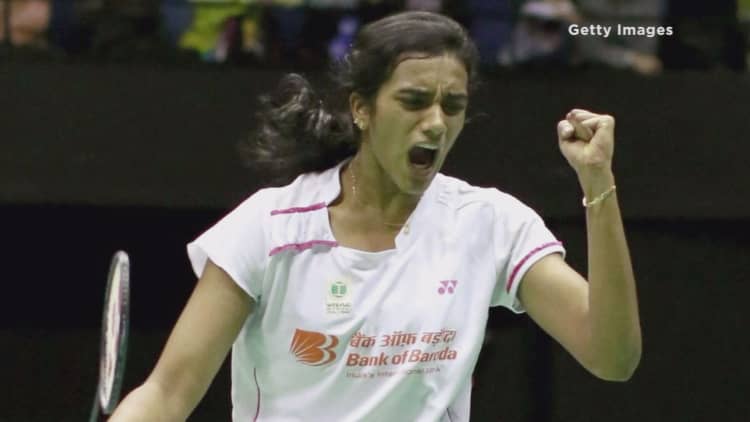
India's silver medalist in badminton at the Rio Olympics, 21-year-old PV Sindhu, has become the country's second-highest-paid sports celebrity for endorsements.
Sindhu gets an endorsement fee of up to 12.5 million rupees (about $192,000) a day, according to her agent— that haul is second only to cricket captain Virat Kohli. Last week, Gatorade named Sindhu its first brand ambassador from India, and on Monday she took the stage at a news event for Panasonic.
Those achievements come in a nation obsessed with just one sport, men's cricket, and it's against the backdrop of consistently lower pay for women in India and globally. (The gender pay gap in India across all sectors is a gaping 25 percent, according to the 2016 Monster Salary Index.)
Breaking stereotypes
Sindhu went to Rio with no sponsorship deals, but she came back with a medal and a star status that will be difficult to beat. Featured in top lifestyle magazines from Elle to Cosmopolitan, Sindhu is one of the most recognizable faces in India today.
"Before the Olympics when we reached out to sponsors, often we were asked 'Sindhu who?''' said Tuhin Mishra, the group managing director of Baseline Ventures, the company that takes care of Sindhu's commercial interests. "The market dynamics were tough. Everyone only wanted to be associated with cricket."
But Mishra and the team who chose to back Sindhu and badminton in a country crazy about cricket and Bollywood are now reaping the benefits of their conviction. The mega star is already the ambassador for more than half a dozen brands, ranging from a bank to a health drink — and there are several more in the pipeline.

She commands a premium of easily 50 percent over her female peers. And while Kohli, a veritable demigod in India, is a clear winner, no other current cricketer has the X-factor to compete with Sindhu in star power, industry insiders said.
Marketers say Sindhu stands for grit and hard work in their eyes, and her image can be both girl-next-door and glamorous.
"Ours is a new product and Sindhu is also a new star. As she grows stronger so will our brand," said Amit Anand, joint managing director of the company that markets the Apis Himalaya honey brand, adding that Sindhu was the first celebrity he'd ever hired.
While sponsors are always on the lookout to cash in on an instant hit, Sindhu's team said it is looking beyond those seeking a short piggyback on Olympic glory.
"We don't want advertisers flirting with her success, but who are interested in marriage. She is still to peak in her career — there is still a lot of potential. Sindhu's endorsement fee can easily go up to 15 million rupees (about $230,000) a day," said Mishra.
His optimism is based on the fact that Sindhu is still only 21 and could well be the Indian contingent's flag bearer at the next Olympics in Tokyo.
"In a way, [advertisers] are associating with the captain of the Indian Olympic contingent," added Mishra.
For her part, Sindhu said she stays focused on the game.
"I don't follow these number games and I am happy focusing only on my performance on the court, and the rest — as they say — follows," the ace shuttler told CNBC.
Sindhu has followed her Olympic performance with wins at the China Open, second place at the Hong Kong Open and a quarterfinal place in the prestigious All England Championships.
Try getting the lion's share
Sindhu, has accomplished something that few Indian women could ever dream of — even beyond winning an Olypmpic medal. It could go unnoticed, but she is commanding an endorsement price higher than all but one of her male peers.
In India, the most glaring pay disparities are seen in the movie industry, where female stars are paid less than half of what their male counterparts get — even if they have more hit films. For example, the Forbes 2016 list of top Indian celebrity earners has only two women stars in the top 10.
Another closely-followed Indian industry, the start-up sector, is also notorious for underpaying women. Female entrepreneurs attract only a minuscule percentage of the overall funding that goes into tech start-ups, according to investors and entrepreneurs.
Given this environment, 34-year-old entrepreneur Akanksha Hazari, founder of mass-market consumer and retail data company m.Paani, said she views Sindhu's commercial success as great motivation for girls to take up sports as a career.
Hazari, who herself has faced questions from prospective investors like "why don't you find a male co-founder," said the conversation surrounding gender pay inequality is getting louder in India and "only if you have more women leaders will this gap narrow."
Sindhu may have broken through pay barriers, but she hasn't changed everything yet.
"While what she has achieved is stunning, one Sindhu does not make a summer. We need to see a broader trend to talk about gender comparability. We seem too content with this one story," said Shiv Visvanathan, a social anthropologist at the Jindal School of Government and Public Policy.


